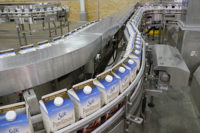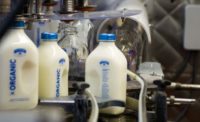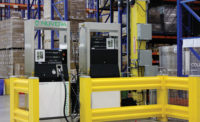What if you knew the future of your company today? What if you learned the secret to saving money and becoming a more sustainable operation? Between LEED
certifications, energy-efficient lighting and an overall cleaner way to do business, going green is proving to save some green along the way.
Refrigerated & Frozen Foods uncovers the latest trends and technologies in green construction to find out what refrigerated and frozen food processors, distributors and cold storage providers are doing to launch their businesses into the future and promote a greener tomorrow—today.
More pounds, less time and equipment
B. Robert’s Foods, LLC, Charlotte, N.C., turned to A M King Construction Co., LLC, also of Charlotte, N.C., to construct a 115,000-square-foot manufacturing facility featuring high-efficiency refrigeration units, 6-inch thick insulated metal panels and energy-efficient T5 lamps with motion-sensing starters. The site also includes Chase doors with auto-close features for areas with a more than 10-degree delta T.
“We have seen a reduction in the carbon footprint since we’ve been in this facility,” says Donald Avera, vice president of operations. “It is a very difficult number to compare against since our growth and addition of new processes has been very rapid. Bottom line—we are getting more pounds through the facility with the same time and equipment [as before the expansion].”
When designing new lines and processes, B. Robert’s Foods also has in place aggressive recycling and waste reduction programs, high-efficiency yield equipment and lean manufacturing principles.
“The one area that I see emerging the most is lean manufacturing,” Avera says. “Companies must make their products faster and with less labor while maintaining the same quality levels. This is accomplished through plant and product design as well as equipment purchases.”
New and improved facility allows for contingency, long-term capacity
Golden State Foods (GSF), Irvine, Calif., broke ground on a new distribution facility in McCook, Ill., that when completed in May 2014, will total more than 158,286 square feet and serve more than 460 McDonald’s restaurants in the Chicago and Midwest regions.
The new and improved facility will facilitate green and sustainable initiatives, including Gold status in LEED, and will allow for contingency and long-term capacity. It will feature a two-story, 17,550-square-foot office component, with 135,120 square feet devoted to warehouse/distribution space, offering a cross-dock configuration with a 40-foot clear height. The new built-to-suit building will also include 52 truck docks, 54,000 square feet of dry storage space and a separate maintenance site totaling 5,700 square feet.
“High-efficiency plumbing systems and fixtures will be installed, reducing potable water usage by up to 30%,” says Dimetria Jackson, director, corporate social responsibility and sustainability. “In addition, rainwater will be captured in a 30,000-gallon cistern for landscape irrigation needs. All wood used in the construction of the building will be FSC-certified, and all construction materials in occupied areas of the building will contain minimal levels of Volatile Organic Compounds (VOCs).”
The freezer/cooler area will incorporate a cascade refrigeration system that maintains 14,040 square feet of cooler storage at 34°F, 23,400 square feet of freezer storage at 10°F and 28,080 square feet of cooler dock staging at 34°F.
Third-party certification is both “worth it” and validating, says Jackson.
“While we all seek to lead in preservation and conservation of our critical resources, we know there are experts to provide validation who have studied this subject matter and provide a critical path to follow in achieving measurable results,” Jackson adds. “It also should not be costly to do good in these areas and far more preferable to achieve efficiency and decreased emissions while maintaining fiscal integrity.”
Golden State Foods was named one of Refrigerated & Frozen Foods’ Top 6 companies to watch in 2013, the December 2012 issue.
From sustainable supply chain to LEED-certified
In July 2008, Hormel Foods Corp. broke ground on a new plant in Dubuque, Iowa. The $89 million project would be the first manufacturing facility the company built from the ground up in more than 25 years.
A year-and-a-half later, the 348,000-square-foot Progressive Processing facility officially opened its doors and began production of Hormel Compleatsmicrowavable meals. From the reflective roof and parking surfaces to the premium-efficiency electric motors and intricate processes like the gray water recovery system, Progressive Processing was designed to be as efficient and environmentally-friendly as possible. As a result, the facility was one of the first manufacturing plants—and the only refrigerated food processing facility in the United States—to be LEED certified at any level.
Furthermore, Hormel Foods was awarded LEED Gold certification for the Corporate Office North addition to its Austin, Minn., headquarters. Some of the sustainable features of the 28,000-square-foot addition included a geoexchange heating and cooling system; lighting controls that monitor needs based on daylight, occupancy and time schedule; reflective roofing materials that reduce heat load from solar radiation; a gray water system that utilizes rain and groundwater; and recycling collection areas.
To recognize new thinking and encourage green projects that drive resource efficiency, Hormel Foods established the Environmental Sustainability Best of the Best annual competition, says Tom Raymond, director of environmental sustainability.
“This program is designed to reward and recognize teams that have identified areas for improvement and implemented changes that make a measurable difference in the reduction of environmental impact and help Hormel Foods achieve its environmental goals,” he says. “The competition has grown since its existence—34 projects were submitted in 2008 (the first year of the competition). By 2011, the competition generated 43 entries throughout all business segments that resulted in the reduction of 695.2 tons of solid waste to landfill, an increase in recycling tonnage by 27% and more than 40.4 million gallons of water saved collectively. In 2012, 61 projects were submitted.”
Hormel Foods received Refrigerated & Frozen Foods’ 2013 Sustainable Supply Chain of the Year award, the May 2013 issue.
Clean energy, clean way of doing business
The Kroger Co., Cincinnati, unveiled a clean energy production system that will convert food that can’t be sold or donated into clean energy to help power its Ralphs/Food 4 Less Compton, Calif., distribution center.
The anaerobic conversion system will process more than 55,000 tons of organic food waste into renewable energy annually and provide power for the 650,000-plus-square-foot distribution center. By diverting that food waste—equivalent to 150 tons per day—the system will also reduce area truck trips by more than 500,000 miles each year.
The Kroger Recovery System uses a sophisticated process to convert the carbon in organic material into a renewable source of methane.
“We are committed to finding solutions for food waste and clean energy, and we believe this is a meaningful step forward,” Rodney McMullen, president and COO of Kroger, says in a press release. “Investing in this project is a good business decision for Kroger, and most importantly, an extraordinary opportunity to benefit the environment.”
The Kroger Recovery System, designed and operated by FEED Resource Recovery Inc., a Boston-based clean technology company, utilizes anaerobic digestion, a naturally occurring process, to transform unsold organics and onsite food processing effluent into renewable biogas. This biogas is then turned into power for onsite operations. The process is carried out in an enclosed, oxygen-free environment, which takes up less space and generates no odors. The system will also provide enough renewable biogas to offset more than 20% of the energy demand of the Ralphs/Food 4 Less distribution center.
Combining the use of renewable energy power with more than 150 zero emission fuel cell forklifts, the Ralphs/Food4Less distribution center is now one of the greenest and most efficient of the Kroger group.
Revving up the refrigeration design
H.E. Butt Grocery Co., San Antonio, Texas, opened a new 83,000-square-foot store as part of the redevelopment of its old Austin, Texas, airport site, which focuses on sustainability and energy efficiency.
“It is just the way we operate our business,” says Bill Triplett, vice president of planning, design and construction. “Our vision is to move faster, save energy and
“Our vision is to move faster, save energy and be sustainable." |
be sustainable. HC [or hydrocarbon] refrigerants have my attention, and I want to move H-E-B in a different direction away from CFCs [chlorofluorocarbons].”
H-E-B enforced four requirements from the refrigeration design—energy efficiency, simplicity (design and install), sustainability and reliability.
“Our ultimate goal with this project is a 70% energy reduction from all the store systems,” says Charlie Wernette, director of engineering. “We believe that a R290 hydrocarbon (propane) system will achieve approximately 50% energy reduction compared to our typical store refrigeration load. Based on the tests and analysis we have conducted to date, we believe that the actual sustainability and energy reductions will far exceed any measurement used today by LEED and GreenChill. In addition, we wanted to find another natural refrigerant alternative, as we are not convinced that CO2 is the long-term solution for H-E-B.”
H-E-B and Hussmann, a Bridgeton, Mo.-based manufacturer of energy-efficient refrigeration systems, began working together in October 2011 to identify the design criteria and specifications to use propane for a majority of the refrigerated display cases in the store.
“Keeping in mind H-E-B’s four requirements, we have designed and engineered a propane system that will enable them to achieve their energy reduction goals while maintaining a safe, shopper-friendly environment,” says Phil Evans, senior vice president of engineering for Hussmann.
Reducing energy costs with a few lighting adjustments
Tops Friendly Markets, Buffalo, N.Y., selected energy-efficient LED lighting from Cree, Inc., Morrisville, N.C., to illuminate its 51,364-square-foot store in Geneva, N.Y.
The store, which opened in November 2012, features Cree CS18 luminaries and CR24 troffers lighting the aisles, specialty departments and pharmacy for an estimated energy savings of 70% over the original T5 fluorescent lighting.
“Tops Markets has always been progressive in designing energy efficiency into its store. When we heard about the Cree CS18linear luminaire, we conducted a test installation in Buffalo and the results were excellent,” Dan Jaskza, energy consultant for Tops Markets says in a case study published on www.RFFmag.com. “Not only did the Cree LED lighting product offer us 70% energy savings [over the previous T5 fluorescent design], but also improved lighting quality without compromising lighting levels.”
Featuring Cree TrueWhite Technology, Cree CS18 and CR24 architectural troffers provide exceptional color rendering, helping to improve the visual shopping experience by making the merchandise colors more vibrant and appealing. In addition, the Cree CS18troffers solve the need for strong vertical light levels when mounted on the store’s 13-foot ceiling.
“Consistent, high-quality light levels from top to bottom of the shelf are a critical need for retailers as they look to enhance the overall shopping experience,” says Mike Bauer, vice president of lighting sales, Cree. “The CS and CR troffers deliver the lighting quality Tops Markets desires, with the added benefits of low-maintenance and energy efficiency—ultimately supporting the bottom line.”
Designed to offer up to 100,000 lifetime hours, Cree CR24 troffers provide dimming capabilities—key considerations for the 24-hour store. Tops Markets estimates the Cree system will pay for itself within 2.5 years.
“For any supermarket operator today, whether they are building a new store or implementing an upgrade, Cree LED lighting is a must-do solution,” Jaszka adds. “It offers energy savings, quality of light and is also fantastic in terms of maintenance reduction.”
A second Tops Markets location featuring Cree CS18 luminaires and round interior pendants are currently under construction.
“Going green while growing greens”
Deardorff Family Farms of Oxnard, Calif., turned to Kingspan Insulated Panels North America, Deland, Fla., to elevate its new headquarters and refrigerated processing/shipping facility to LEED Gold status. As a result, Deardorff, a fourth-generation vegetable processor situated on 2,000 acres, more than doubled its ability to cool, process and pack its array of organically farmed crops.
Armed with a new company slogan, “Sustainable farming for a healthier life,” Deardorff worked with ADS Group Architecture & Development of Ventura, Calif., to select an infill site—a building that previously housed a barley processing facility—to minimize environmental impact and utilize existing resources. The older structure was demolished, and virtually all of the materials were recycled for the new facility.
Deardorff installed sophisticated new technologies, including automated systems to precisely regulate the cooling and sorting of crops for size and quality, along with new equipment to monitor and automate irrigation and energy use.
Kingspan’s Commercial & Industrial (C&I) wall and roof systems consisted of strong, visually appealing metal sheets structurally attached to a thick insulation layer to give exceptional exterior insulating properties and protection against moisture, air infiltration and thermal variability.
“Our new facility was designed and built to improve the environment, meet the highest standards of food safety and create the best possible supply chain efficiency,” says president Tom Deardorff II, who quipped that his company is “going green while growing greens.”
The 102,000 square feet of 4-inch-thick standing-seam KingZip roof panels in standard Kynar Regal White exceeds the high threshold for Solar Reflective Index (SRI) in LEED. That means the roof system delivers a “cool roof” rating while still providing a high R-value of thermal protection. The entire sustainable facility project took just over 18 months to complete.
Instituting the highest coefficient of performance possible
Energy costs are significant for poultry processors. For example, one of Chile’s leading poultry processors relied on boilers to heat up to 350 gallons per minute of well water for their sanitation needs. At the same time, heat was being removed from the poultry being processed and discharged to the environment. As a result, the poultry processor was spending money to buy heat while spending money to waste it.
This poultry processor, who declined to be named, wanted the highest coefficient of performance (COP) possible and a technology solution with low annual operating and maintenance costs. The system needed to use a non-ozone-depleting refrigerant with little global warming impact.
One of the few refrigerants that could meet all of their efficiency and environmental requirements was ammonia—a refrigerant (designated as R-717) most commonly used by the food and beverage industry for process cooling and refrigeration. Ammonia is said to not contribute to ozone depletion or global warming, and can be used in a heat pump to reduce total energy demand.
Vilter single screw compressors from Emerson Climate Technologies, Inc., Sidney, Ohio, offered an ammonia heat pump solution that delivers hot water for sanitation at 126°F using heat extracted from refrigeration. With the new system, heat taken from the poultry processor’s 14°F refrigeration load is lifted to 126°F in one stage for heating.
Since commissioning in January 2012, the Chile facility is heating 350 gallons of water per minute. And, the hot water is delivered far more efficiently than from their previous boiler. In fact, the ammonia heat pump solution reduced heat energy cost by 72% and saved 15 million gallons of water per year.
Today’s refrigerated and frozen food processors, distributors and cold storage providers hold the secret to implementing futuristic technologies without having to spoil the fate of tomorrow.











